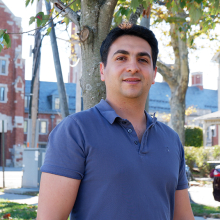Coronavirus by the numbers
A measured approach to understanding—and defeating—the COVID-19 pandemic
Briefs

The SARS-CoV-2 pandemic is a harsh reminder that, whether the virus is spreading within a single human host or in a wave of infection spanning continents, many of the most critical answers we seek about this unprecedented epidemic are expressed in numbers. Quantitative questions include: How long does it take a single infected person to infect a million others? How long does the coronavirus remain stable on surfaces? How effective is social distancing, and how many lives can this policy potentially save?
More than a decade ago, during his postdoc at Harvard Medical School, Prof. Ron Milo created an online, shareable resource for “bio-numbers”—values culled from the scientific literature that relate to biological processes as they occur on all scales, from the level of atoms and molecules, to the levels of organisms and ecosystems. Over the years, Prof. Milo’s initiative grew into a massive database called BioNumbers that allows scientists around the world to search bio-based data to find answers to their questions, and to identify interesting questions that had never occurred to them before.
Now, he and his colleagues are applying the same approach to the fight against the coronavirus. Those colleagues are Yinon Bar-On, a PhD student in the Milo lab at the Weizmann Institute’s Department of Plant and Environmental Sciences, Prof. Rob Philips from the California Institute of Technology, and Dr. Avi Flamholz of the University of California at Berkeley.
In a recent publication in eLife, the researchers used existing peer-reviewed literature to create something that could well be called “Corona-by-the-numbers”—a comprehensive collection of the key biological properties currently known about the coronavirus that can be measured in numerical terms. They will be curating these numbers, and updating them as new data emerge from laboratories, clinical centers, and public health authorities worldwide.
A vast number of scientific insights could potentially emerge from the use of this data. For example, the carefully curated values may spark new ideas about how the immune system could be stimulated to fight the virus. They may reveal how the coronavirus is similar to, or different from, other viruses against which preventative strategies already exist. Measurements of viral particle concentration could aid in the design of diagnostic kits for asymptomatic patients. And by offering measurements of factors that influence the speed at which the disease spreads, the data Prof. Milo and his colleagues compiled may lead to new strategies for protecting populations worldwide.
“Knowledge of the numbers related to the coronavirus can give us a ‘sixth sense’ that allows us recognize what we can’t see or feel—thereby serving as a basis for thoughtful, quantitative insights that may lead to important discoveries,” Prof. Milo says. “We have already shared our numbers with the 40-plus groups at the Weizmann Institute who are currently working around the clock on coronavirus-related research, as well as other researchers around the world. Now that this resource is published and available freely online, we believe that this will improve the global scientific community’s ability to share knowledge, and work together effectively against the pandemic.”
Prof. Milo is Head of the Mary and Tom Beck - Canadian Center for Alternative Energy Research. He is supported by Dr. and Mrs. Brian Altman, Dana and Yossie Hollander, the Larson Charitable Foundation New Scientist Fund, the Ullmann Family Foundation, the Zuckerman STEM Leadership Program, and the European Research Council. He is the incumbent of the Charles and Louise Gartner Professorial Chair.








